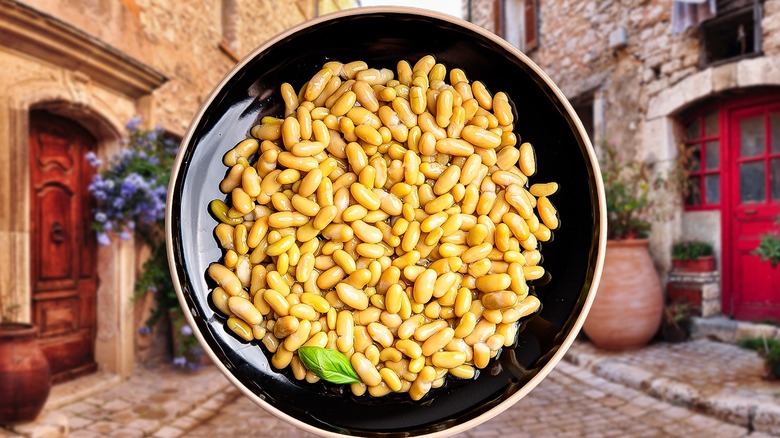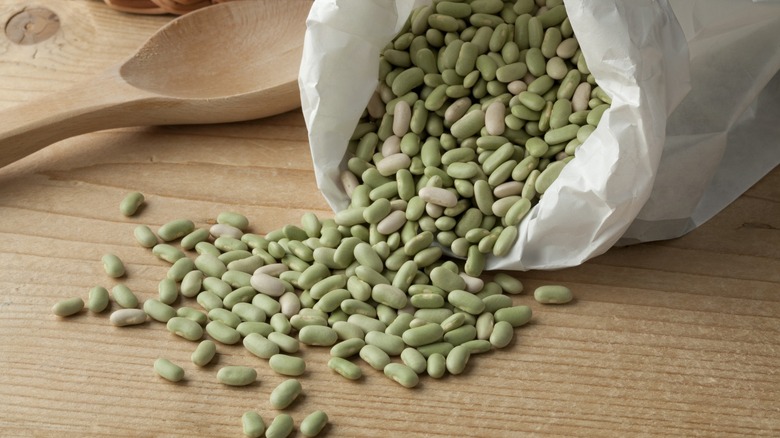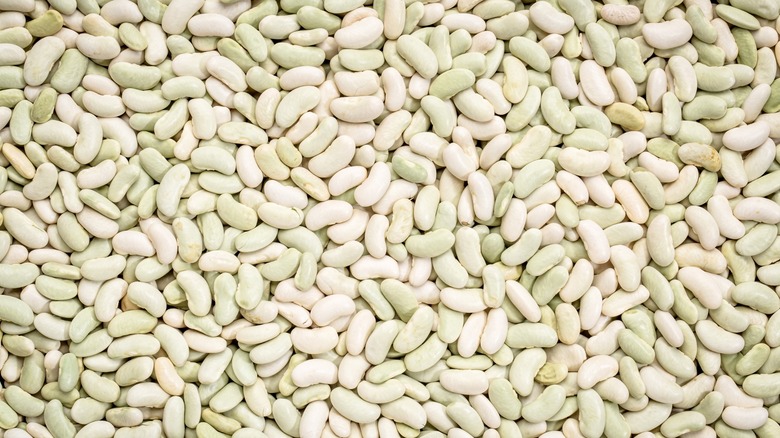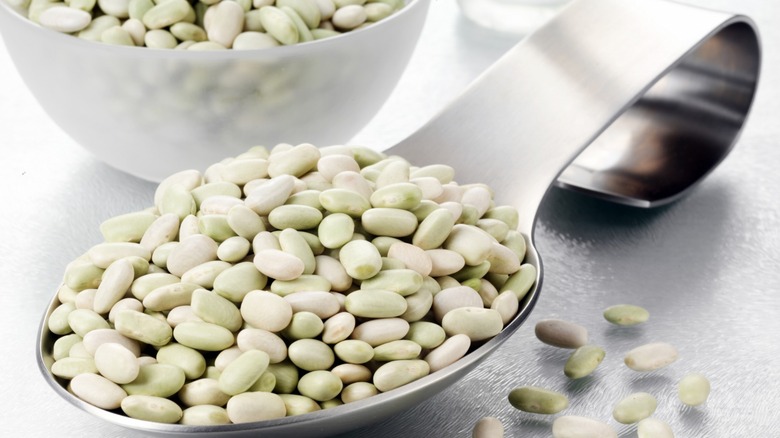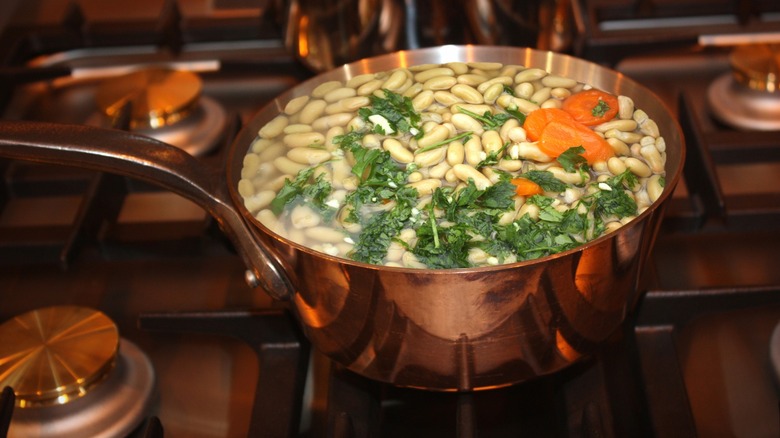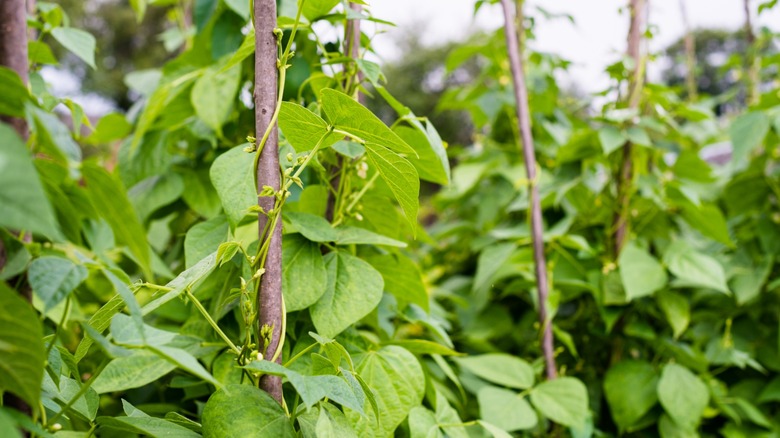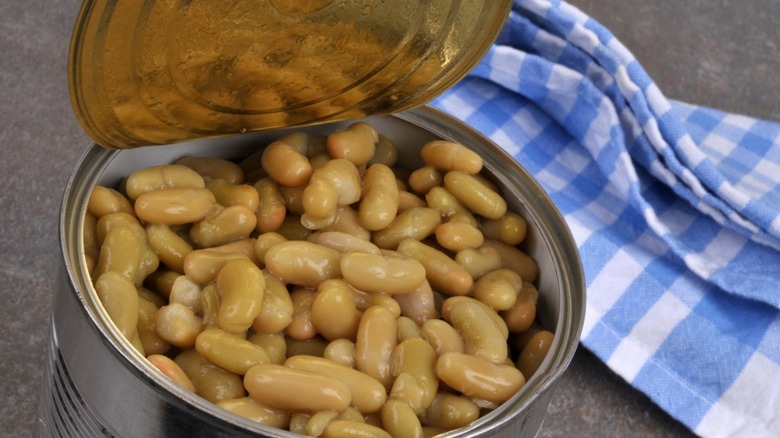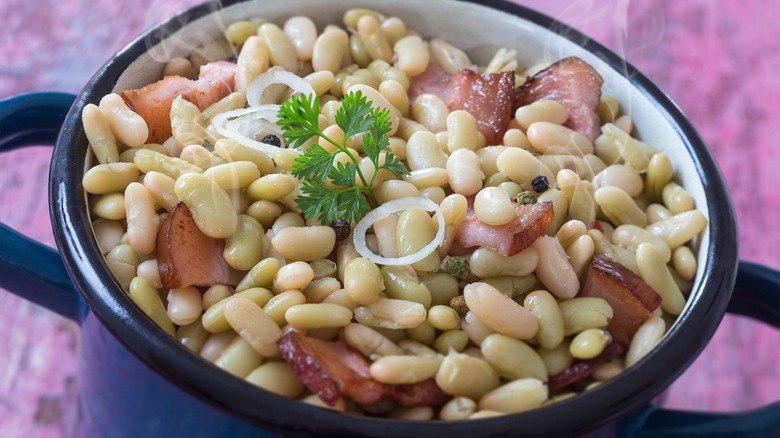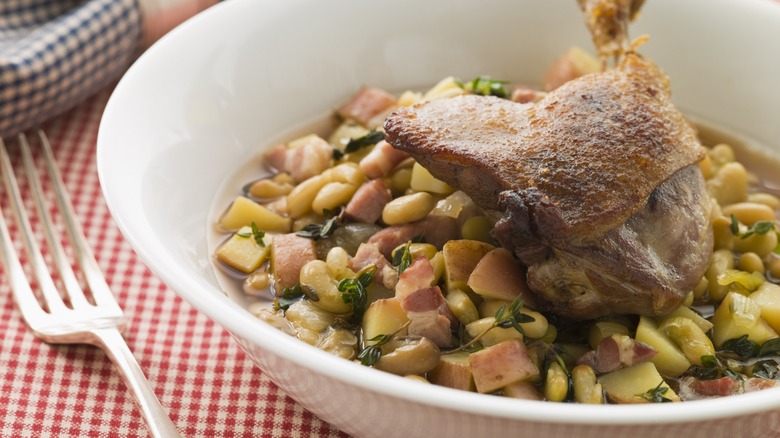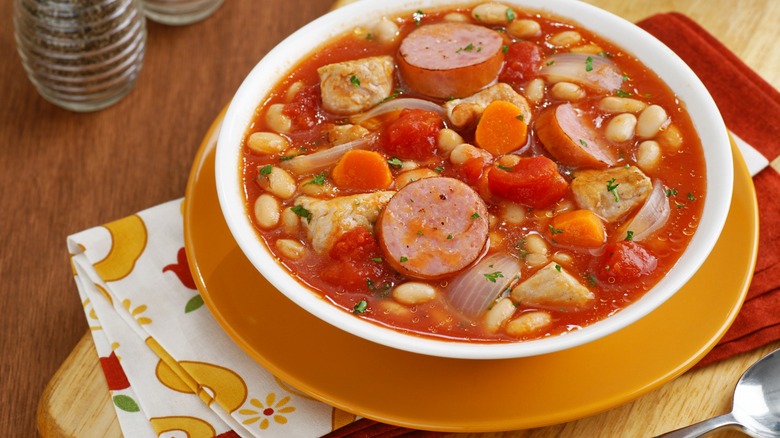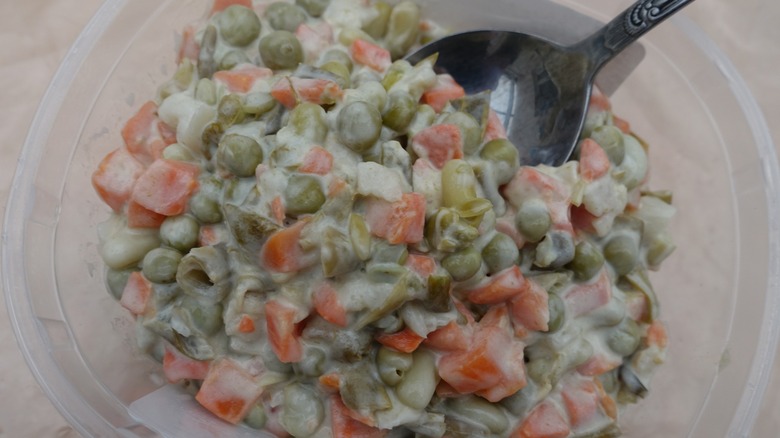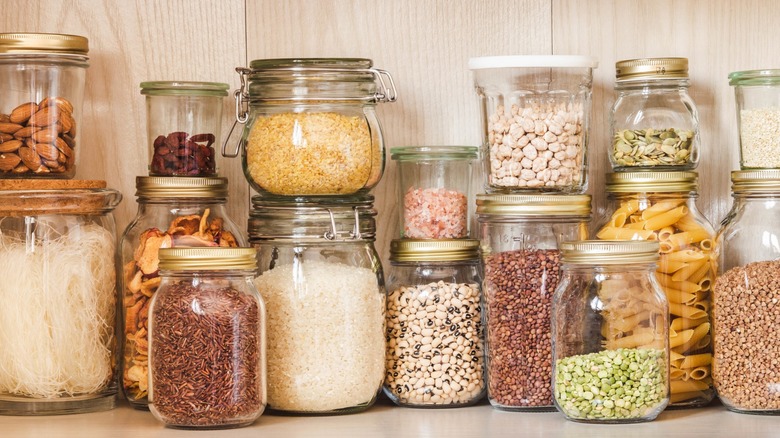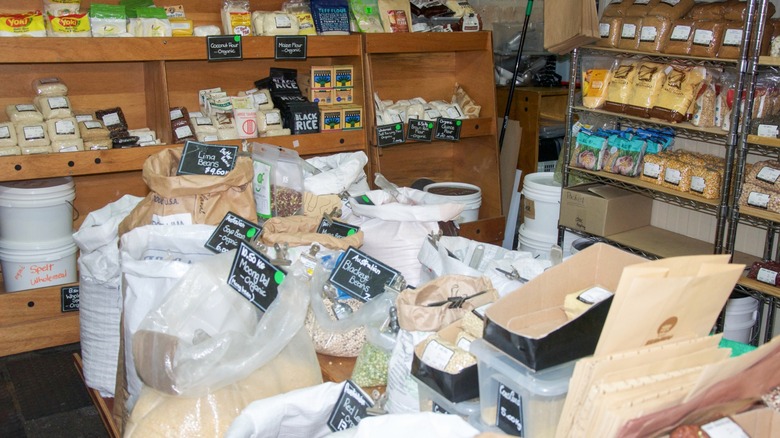Flageolet Are The Creamy French Beans You Should Know
We may receive a commission on purchases made from links.
Beans are the one food source that most people can embrace. They are equal parts nutritious, substantial, and affordable. They can sit in your pantry for long periods. They complement meat dishes but are also a hardy source of protein for vegetarians and vegans. And they are so flexible! Add them to your soups, your salads, or as a stand-alone one-pot meal. You can even make delicious sauces and dips with them.
In the U.S., we tend to stick to a handful of varieties: kidney, Navy, or white beans. On occasion, we might use chickpeas in our recipes. All of that makes for a fairly blasé take on classic dishes like chili or stew.
That's why we'd love to introduce you to something new to add to your pantry: flageolet beans. These are typically used in French dishes. While they resemble lima beans, they are more akin to Navy or white beans with some important differences. These flavor nuances will open up opportunities to upscale your bean dishes so you can dazzle your guests. Simplicity never tasted so good as it does with flageolet beans.
What are flageolet beans?
Frequently called the caviar of beans, flageolet (pronounced "flaj-e-let") is a type of kidney bean harvested before it becomes fully mature. They are dubbed with the title caviar because they are tiny and delicate, yet richer and creamier than other popular types of beans. This, plus its French background, gives it an air of sophistication. It's also an excellent replacement to upscale any of your bean recipes that call for white beans, such as cannellini, Navy, or Great Northern beans.
Flageolet beans are a variety of shell beans. The shells are removed, leaving only the pod, or seed, intact for consumption. This is different from other beans, such as green beans, where you eat the pod and the shell together.
Flageolet beans come in several colors, including black and red, but the white or green ones are the most common type you will find in the U.S. In France and part of the European Union, flageolet beans are available frozen or in jars and cans. However, in the U.S., it's easiest to buy the dry beans.
The origin of flageolet beans
Like Navy, Great Northern, and cannellini beans, flageolet belongs to the species Phaseolus vulgaris. Developed in France in the 1800s, all the beans in this species have the same distinctive oval-like shape and similar nutritional values. This bean was originally called Laon Early Dwarf. Flageolet was its trade name, and it covers all the varieties.
Of the various colors of flageolet beans, green is the most common. It's actually a type of white flageolet bean that holds onto its chlorophyll content. Chlorophyll is a plant pigment that has many nutritional qualities. Flageolet beans were first produced for commercial use in 1878 by a grower named Gabriel Chevrier. Because of this, the bean is sometimes officially called Chevrier vert, vert being the French word for green.
Chevrier vert is a type of heirloom bean handed down through the generations without crossbreeding. Classified as an endangered species in France, the heirloom plant naturally grows in close contact with the soil. This makes it vulnerable to disease and plant predators.
Today, only a handful of companies produce the heirloom version of flageolet beans. Because the plants are highly susceptible to predators and disease, growers often treat them with many chemicals. Some beans are covered in blue or pink residue due to the dust of these treatments. If you can find flageolet beans, we recommend buying organic certified versions.
Flageolet nutrition facts
Like many other haricot beans, flageolet beans are a good source of fiber and protein. They have thinner skin than other bean varieties in this species so that your body can access the fiber more easily, which helps digestion. One serving of raw, semi-dried seeds contains over 19 grams of protein and 23 grams of fiber. They are also rich in vitamins, minerals, and electrolytes. These beans also contain beta-carotene, an important phytonutrient.
Flageolet beans are a great meal choice for people watching their calories and fat content. One hundred grams of these beans contain 90 calories and less than one gram of fat. The beans are a great source of B vitamins. One example is folate, which helps healthy red blood cells to develop. It's also a crucial nutrient for pregnant women as it promotes healthy DNA and cell division. Flageolet also contains vitamin C, which supports your immune system, and vitamin E, to promote healthy skin.
Flageolet beans contain high levels of essential minerals, including selenium, copper, manganese, phosphorus, and zinc. They are a good source of potassium, an electrolyte that is necessary to keep your body in balance by regulating sodium levels. The fiber in these beans can help to eliminate harmful chemicals in the colon, such as cancer-causing agents. These nutrients work together to keep your body functioning properly
Using caution when cooking and eating flageolet beans
Flageolet beans are great for your health, but not everyone can tolerate them. There is also some debate on whether or not you can eat them raw. Like all beans, flageolet beans contain lectins, which are known as anti-nutrients. Lectins cause red blood cells to clump together and can be dangerous, especially if you have blood clotting disorders. They also prevent proper absorption of the nutrients in the beans. For this reason, we recommend you do not eat them raw. However, if you choose to do so, soak them first, at least overnight, to combat these problems.
While these beans are very flexible, they contain two sugars, which are a type of fermentable oligosaccharides, disaccharides, monosaccharides, and polyols (known as FODMAP). These sugars quickly ferment in your colon, which can cause irritable bowel syndrome, or IBS, symptoms. People who are avoiding complex carbs, are on a FODMAPs diet, or suffering from IBS should avoid flageolet beans.
Flageolet beans can cause gas, so keep that in mind when serving them. Parents should note that while beans are generally a great source of nutrition for babies, flageolet beans may not be suitable for children under 15 months of age. It can cause gastrointestinal distress or extra gas in young children.
Growing flageolet beans
While they originally hail from France, in the U.S., flageolet beans are grown in California, where the soil is rich and fertile. Their delicate flavor comes from the fact that they are harvested before maturity.
Flageolet bean seeds are not easy to find; there are a few places where you can purchase them in the U.S., such as Prairie Road Organic or Johnny Seeds. Flageolet beans are aptly named pole beans because they require support structures, such as a trellis, to grow up straight. Pole beans develop long stalks that droop toward the earth, making them more susceptible to predators or diseases found in the soil.
Flageolet beans take 60 to 90 days to grow but should be picked one to two weeks after flowering. The pod will be firm, but the seed inside is still developing. If you get the timing wrong, the beans can be too mushy or too tough to taste good.
Of course, the pods are also the seeds. Once fully developed, you can harvest the plants for replanting. Be sure that at least 80% of the plant is ripe when harvesting. Then pull out the entire plant. If you're not ready to remove the pods, store them in an airy, sunny location. Flageolet beans thrive in a wide range of pH levels in high-quality soil but must be grown in direct sunlight. You can raise these plants alongside compatible vegetation such as corn, pumpkin, lettuce, celery, or cucumber.
Dried flageolet beans vs. canned or frozen
In France, flageolet beans are available canned, jarred, or frozen. However, in the U.S., only the dried variety is widely available. So what is the difference?
Canned and jarred beans are the easiest to use. They are already cooked. Simply heat them or add them to the dish you are cooking. Dried beans are the most affordable form because you need to do all the prep work for them. They expand when cooked, so a 32-ounce bag can yield up to six cups of cooked beans, while a 15-ounce only holds about two cups.
As mentioned, soaking dried beans overnight reduces FODMAPs, lectins, and other harmful chemicals, making them safer and more digestible. It also reduces the risk of bloating or gas. Soaked beans are better for mineral uptake in the body. and cook much quicker. You can think of it as making canned beans at home for less money.
Cooking tips for flageolet beans
Prep first by soaking the dried flageolet beans to tenderize them for your recipes and for your stomach. However, if you don't want to wait that long — and have a strong stomach — you could soak them for about an hour. Some chefs believe that all they need is a rinse, but we would exercise caution. You want your first flageolet bean experience to be joyful, not painful.
To cook them on their own, simply boil them in chicken stock with salt and pepper and maybe a splash of wine. You can also add mirepoix. This dish is ideal for people who are on highly restrictive diets outside of FODMAPs. Boiling to full tenderness takes 60 to 90 minutes if the bean has not been soaked for a long period of time. Soaking will also help if you want to take the chance and eat them raw. However, we don't recommend this, even if your stomach is made of steel.
Best recipes for cooking flageolet beans
While flageolet beans are comparable to other haricot beans, their creamy texture stands out. They also retain shape even after soaking and cooking. Traditionally, French chefs serve flageolet beans with their slow-cooked lamb recipes. The mild flavor makes them ideal alongside meats with rich flavor, like bacon or game meats. They are a flexible choice for a variety of recipes.
Flageolet beans are an ideal option for stews, especially lamb stew. They are a key ingredient in cassoulet recipes. This stew typically contains American bacon and guanciale, pork derived from a pig's jowl. However, you can also create a vegetarian version.
Add cooked flageolet beans to salads. One word of caution: we do not recommend a creamy dressing for this dish. Instead, let the bean speak for itself alongside lettuce, heirloom tomatoes, and lemon drizzle with high-quality extra virgin olive oil and season with Herbs de Provence and a hint of garlic. They also pair well with rosemary and thyme.
Replacing other beans with flageolet
With their mild flavor and creamy texture, flageolet beans are a flexible variety to shake up your typical bean recipes. It's easy to substitute them for cannellini or Great Northern bean recipes since all three have a mild flavor. We do not recommend replacing kidney beans with flageolet, but you can use them for a tasty meat recipe.
Because they are delicate and creamy, exercise caution when cooking. For example, if you're adding them to chili, keep an eye on them so they don't get too soft in your slow cooker. By the way, if you're upgrading your beans, you can upgrade your chili meat too. We recommend pork rather than beef, as porcine notes are accentuated by the bean's smooth flavor. Flageolet beans are also an ideal substitute for cannellini in white chicken chili recipes.
Because they go well with rich flavors, add them to your red sauce-based soups or one-pot meals. And we can't think of a better way to upgrade the classic dish pasta e fagioli, that delicious Italian comfort food, than adding flageolet beans instead. You won't regret the delicious results.
Creative ways to serve flageolet
Thanks to their creamy consistency and mild flavor, there are many creative ways to serve flageolet beans. First off, you can use them to create a dairy-free, white bean alfredo sauce. Soaked and cooked flageolet beans are an ideal replacement in this recipe. They should get to the right texture more quickly than the cannellini.
Their creamy texture also lends well to pureed dips and soups. A velvety flageolet bean dip made with fresh herbs and garlic makes a show-stopping appetizer for guests. You can also spice up your dips with artichoke, bacon, and spinach. Mix the beans up with stronger flavors like jalapenos or Cajun seasoning. Use flageolet beans to make your dips dairy-free, or add vegan cheese to make it even richer. Flageolet beans are very flexible for all kinds of recipes. We even discovered flageolet bean pie, a savory dish, of course.
Storing and preserving flageolet beans
Whether you buy these beans canned, frozen, or dried flageolet beans, you'll want to give this delicacy the best shelf life possible. Flageolet beans are sensitive to light and humidity, so storage is critical. After purchasing, check that your beans are in good order.
Store them in a dry location, keeping temperatures between 50 F and 70 F, so they don't get moldy. Keep them away from light and give them plenty of ventilation. And don't store them near strong-smelling foods or substances because they may pick up the scent. When putting them in a container, make sure it's airtight. We recommend glass jars with solid lids or plastic containers. If you need to store them longer, consider freezing them. If you do, first blanch the beans, then dry them completely.
For growers, once you've harvested the beans, drying them is your best bet for a long life. Lie them flat to dry, which hardens them. Then store as suggested above. Your final option is canning. Again, be sure they are thoroughly soaked and cleaned before starting the process. Preserve them in either water or vegetable broth. Follow your typical method for canning.
Because they are susceptible to mold and other microorganisms, check the beans regularly. Look for visual signs of mold or rot and a bad smell. Discard all affected. For dried beans, we recommend throwing out the whole batch. Even if the rest have not gone bad, the taste could be tainted.
Where to buy flageolet beans
You can buy dried flageolet beans easily in the U.S. online. You won't generally find them in the supermarket. To purchase in a store, you need to find a French grocery specialty store such as La Panier Francais, but we recommend checking ahead to see if they are in stock. Your best is to find a shop online that ships to you.
Walmart and Whole Foods both carry the brand Zursun. Surprisingly, Bob's Red Mill flageolet beans are on Instacart but not available for sale on the brand's website itself. Amazon carries the dried beans, too. However, there is only one brand of these canned beans, the only variety we could find online.
If you're in a major city like New York or San Francisco, specialty grocery shops are more common. You may also be able to find them in the bulk aisle at Whole Foods at those locations, but again, call and ask first.
